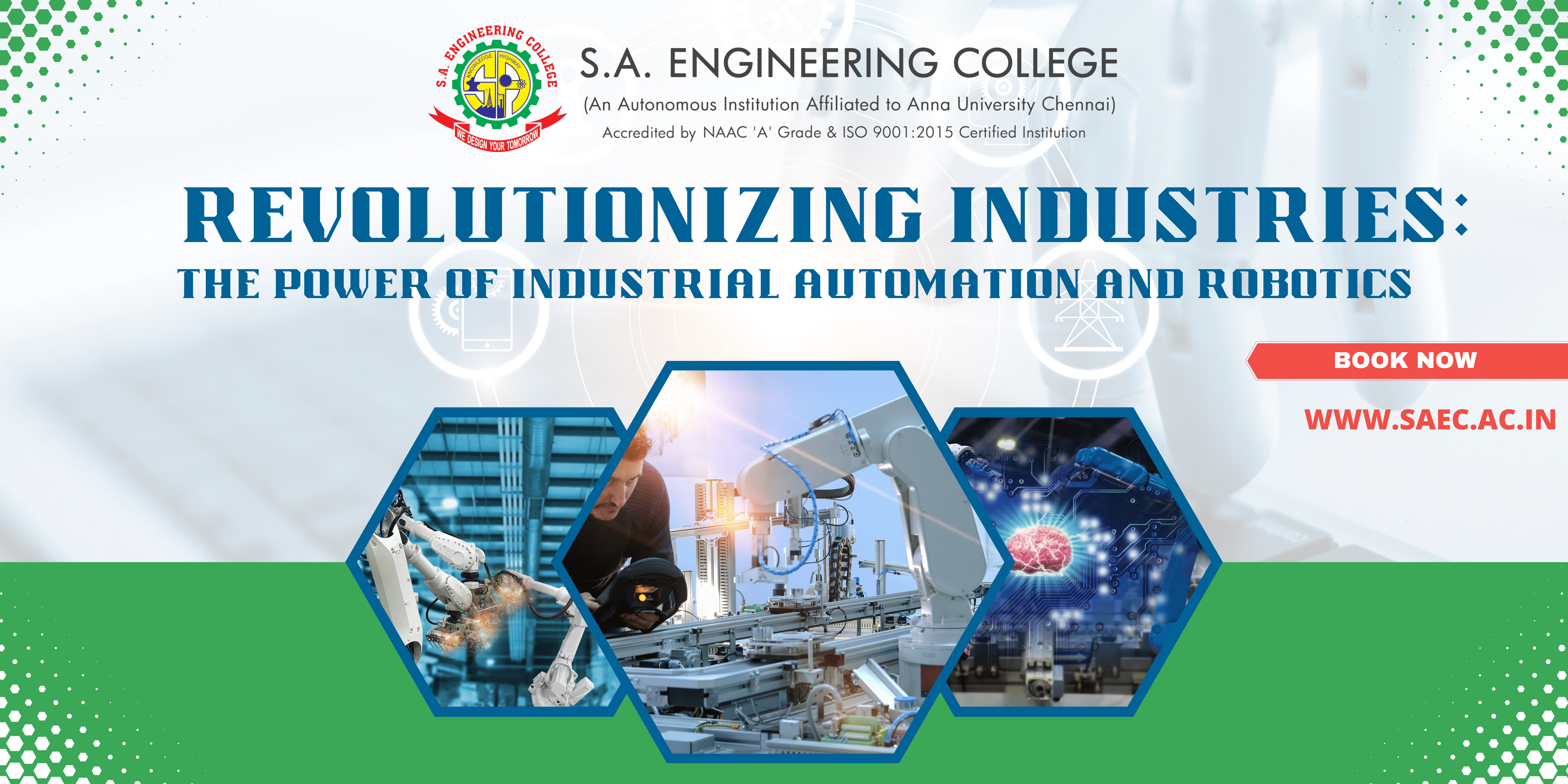
Revolutionizing Industries: The Power of Industrial Automation and Robotics
In recent years, the landscape of industries worldwide has been undergoing a profound transformation, largely driven by the integration of automation and robotics. From manufacturing plants to warehouses, healthcare facilities to agriculture, the applications of these technologies have revolutionized productivity, efficiency, and safety across various sectors. In this blog, we’ll delve into the realm of industrial automation and robotics, exploring their impact, benefits, challenges, and prospects.
1. Understanding Industrial Automation:
Industrial automation refers to the use of control systems, such as computers or robots, to handle different processes and machinery in an industrial setting. These systems aim to replace or augment human intervention in tasks ranging from simple repetitive actions to complex operations. Key components of industrial automation include sensors, actuators, controllers, and human-machine interfaces.
2. The Rise of Robotics in Industry:
Robotics plays a central role in industrial automation, providing the physical means to execute tasks with precision and speed. Modern industrial robots are versatile, agile, and equipped with advanced sensors and AI algorithms, enabling them to perform a wide range of functions. These include assembly, welding, painting, packaging, material handling, and even collaborative tasks alongside human workers.
3. Benefits of Industrial Automation and Robotics:
– Enhanced Productivity: Automation streamlines processes, reduces cycle times, and increases output, leading to higher productivity levels.
– Improved Quality: Robots ensure consistency and precision in manufacturing, resulting in fewer defects and higher-quality products.
– Cost Efficiency: While initial investment costs may be high, automation ultimately leads to long-term cost savings through reduced labor, lower error rates, and optimized resource utilization.
– Safety: By taking on hazardous or physically demanding tasks, robots help mitigate workplace accidents and ensure a safer environment for human workers.
– Flexibility: Automation systems can be reprogrammed and reconfigured to adapt to changing production needs and accommodate diverse product lines.
4. Challenges and Considerations:
Despite the numerous benefits, the adoption of industrial automation and robotics also presents challenges and considerations for businesses:
– Initial Investment: Implementing automation requires significant upfront investment in equipment, infrastructure, and training.
– Workforce Transition: The shift towards automation may entail workforce restructuring and upskilling to ensure employees can adapt to new roles and technologies.
– Integration Complexity: Integrating automation systems with existing processes and legacy equipment can be complex and require careful planning.
– Ethical and Social Implications: Automation raises concerns about job displacement, income inequality, and the ethical implications of autonomous systems in decision-making processes.
5. Future Trends and Opportunities:
Looking ahead, the future of industrial automation and robotics holds immense potential for innovation and growth. Key trends and opportunities include:
– Advancements in AI and Machine Learning: AI-powered robots will become more intelligent, autonomous, and capable of learning from their environments.
– Collaborative Robotics: The rise of cobots, or collaborative robots, will enable closer human-robot interaction, enhancing productivity and safety.
– Internet of Things (IoT) Integration: IoT technologies will enable seamless connectivity and data exchange between machines, leading to predictive maintenance and real-time optimization.
– Industry 4.0 and Smart Factories: The concept of Industry 4.0 will continue to drive the integration of automation, data exchange, and IoT in manufacturing, creating interconnected, intelligent production systems.
6. Application of Industrial Automation and Robotics Across Industries:
Manufacturing: In the manufacturing sector, industrial automation and robotics have revolutionized production processes, leading to increased efficiency and precision. Automated assembly lines, robotic arms, and 3D printing technologies have streamlined manufacturing operations, enabling mass customization and just-in-time production.
Logistics and Warehousing: Automation has transformed logistics and warehousing operations, with autonomous guided vehicles (AGVs) and robotic forklifts facilitating the movement and storage of goods in warehouses and distribution centers. Automated sorting systems and robotic pickers have also optimized order fulfillment processes, reducing errors and delivery times.
Healthcare: In healthcare, robots are increasingly used for tasks such as surgery, medication dispensing, and patient care. Surgical robots, for example, enable minimally invasive procedures with greater precision and control, leading to faster recovery times and reduced risk for patients. Robots are also employed in rehabilitation therapy, eldercare, and laboratory automation, enhancing healthcare delivery and patient outcomes.
Agriculture: Automation and robotics have transformed agricultural practices, improving productivity and sustainability in farming. Automated machinery such as drones, tractors, and harvesters aid in planting, monitoring, and harvesting crops, while robotic systems for weed control and pest management reduce the need for chemical interventions, leading to more environmentally friendly farming practices.
Construction: The construction industry is embracing automation and robotics to enhance productivity and safety on job sites. Robotic bricklayers, 3D printing technologies, and autonomous construction vehicles are revolutionizing building processes, enabling faster construction times, reduced labor costs, and improved worker safety in hazardous environments.
Energy and Utilities: Industrial automation plays a crucial role in the energy and utilities sector, optimizing the generation, transmission, and distribution of power. Automated control systems monitor and regulate energy production processes, while robotics are employed for maintenance tasks in power plants, offshore platforms, and pipelines, ensuring operational efficiency and reliability.
7. Environmental Impact and Sustainability:
Industrial automation and robotics have the potential to drive significant environmental benefits by reducing resource consumption, waste generation, and carbon emissions. Through optimized production processes, energy-efficient operations, and precision farming techniques, automation contributes to sustainable practices across industries, fostering a more environmentally conscious approach to industrialization.
8. Ethical and Social Implications:
As automation continues to proliferate, there are important ethical and social considerations to address. The potential for job displacement and income inequality raises concerns about the equitable distribution of wealth and opportunities in society. Moreover, the ethical implications of autonomous systems in decision-making processes, such as self-driving vehicles or automated healthcare diagnostics, require careful consideration to ensure transparency, accountability, and fairness.
9. Global Adoption and Economic Impact:
The adoption of industrial automation and robotics varies across regions and industries, influenced by factors such as technological readiness, labor costs, regulatory frameworks, and market demand. While advanced economies have been early adopters of automation, emerging markets are increasingly investing in these technologies to enhance their competitiveness and productivity. The economic impact of automation is significant, with studies suggesting that every robot deployed in the manufacturing sector creates additional jobs and contributes to GDP growth through increased productivity and innovation.
Conclusion:
In conclusion, industrial automation and robotics represent a transformative force shaping the future of industries worldwide. From manufacturing and logistics to healthcare and agriculture, the applications of these technologies are vast and multifaceted, offering unprecedented opportunities for innovation, efficiency, and sustainability. While challenges and ethical considerations remain, the potential benefits in terms of productivity, safety, and environmental stewardship are immense. By embracing automation and robotics and fostering responsible deployment and regulation, industries can navigate the complexities of the digital age and unlock new frontiers of growth and prosperity in the global economy.

